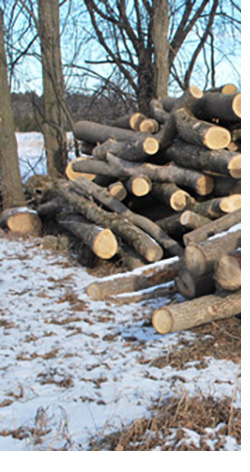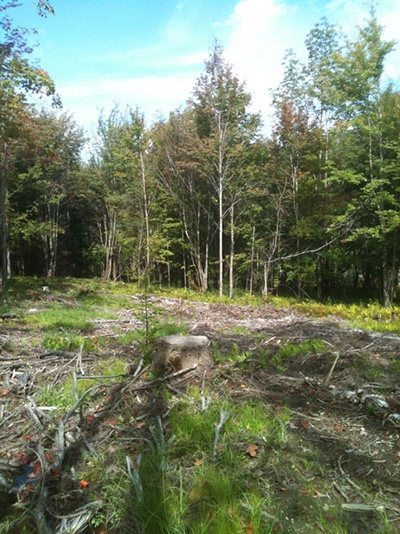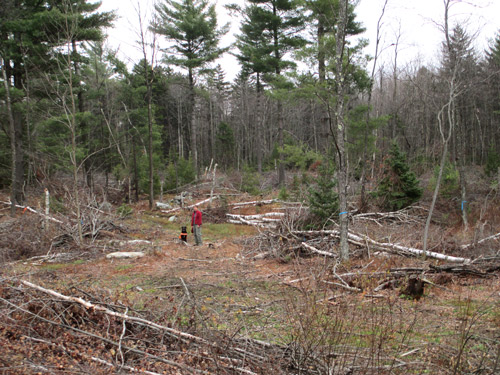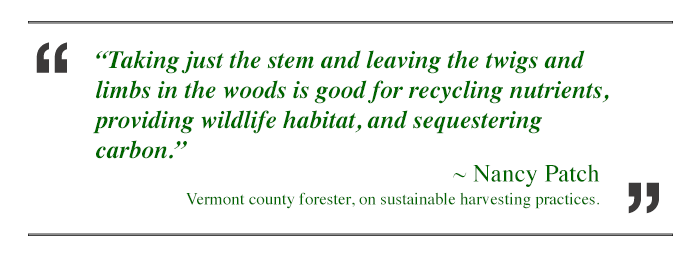| Vermonters Return to Wood Heat: It's Still the Way to Go | ||||||||||
| by Allison Teague | ||||||||||
 |
“Chop your own wood and it will warm you twice.” Or if you are a logger, thrice: cutting the trees and getting the poles out of the woods; cutting, splitting, and stacking the cordwood; and burning it. Many agree that heating with some form of wood, whether cordwood or processed wood in the form of pellets or wood chips, makes more sense now than ever before. In a world where storms knock out electricity, sometimes several times a year, heating with wood in Vermont is just common sense. As EPA standards and technology for wood-burning stoves and boilers have upgraded nearly every year, state officials say burning wood is an efficient and reliable heat source for Vermonters. Wood-cutting lotteries for cordwood burners, state incentives for weatherization and switching to woody biomass (pellets and wood chips), and business incentives to explore some aspect of biomass production and distribution are reinforcing that choice for Vermonters. |
Nancy Patch, forester for Franklin and |
||||||||
I’ve spent nearly six decades heating with cordwood. Among my earliest childhood memories are the daily early morning trips I made outside to the woodpile on the porch. Wrapped tight in my bathrobe, wearing gloves and hat, I brought in armloads to feed the fireplaces of my family’s 1810 Federal-style home. On those cold mornings, nearly imperceptible whiffs of wood smoke lingered in the still valleys, and a breeze brought the scent of my neighbors’ applewood and maplewood fires to my nose, along with that of ozone. In the last century, the seeming abundance and convenience of fossil fuels, along with concerns that particulate emissions in wood smoke were compromising air quality, caused people to switch to oil, gas, and electricity to heat their homes. Many homes built during the sixties, seventies, and eighties were outfitted with oil burners producing either hydrogenic (water) or forced air heat or with electric base heaters. Older Vermont farmhouses were retrofitted with electric-sourced heat or oil-burning furnaces. A few people saw the writing on the wall and constructed off-the-grid homes that relied on a combination of energy sources: wood was usually the primary heat source, with a fossil-fueled backup.
However, with our use of fossil fuels tied irrefutably to climate change, which has caused extreme weather events like 2011’s Tropical Storm Irene, Vermonters are being forced to rethink how they heat and cool their homes. And policy makers have responded with a goal of using 90 percent renewable energy sources by 2050. In 2011, Vermont legislators made moving away from dependence on fossil fuels a priority and established the Comprehensive Energy Plan (CEP). The state set a policy push toward heating with biomass, incentivizing schools and municipalities to switch to biomass-fueled heating systems. All plant matter, as well as wood chips and pellets, are considered biomass. The CEP categorizes agriculture crops and residue, such as grasses, and liquid biofuels as biomass. But the principal source of biomass in Vermont, and the one most accessible to Vermonters, is wood. Wood used for biomass is the lowest quality wood in a forest. The higher quality wood is reserved for furniture makers, artisans, and builders.
Economic Incentives The push toward heating with woody biomass (pellets or wood chips) is spawning new businesses that manage forests and process and deliver woody biomass to residences, institutions, and small businesses. The Vermont Wood Pellet Company in North Clarendon processes wood into pellets, and another pellet plant is soon to open in Windsor. But state officials say that demand exceeds supply, and pellets and wood chips are being trucked in from Maine, Massachusetts, New York, Pennsylvania, and even as far away as British Columbia. Thus, the state has created, through the PSD, incentives that interested Vermonters can cash in on through the Biomass Energy Resource Center (BERC) and the Clean Energy Development Fund (CEDF). In November 2014, CEDF released a request for proposal to design and administer a modern biomass-heating program in Windham County, Vermont. The CEDF plans to allocate $1.6 million for the creation and installation of efficient wood pellet/chip heating systems in schools and municipal buildings in Windham County. This county was singled out because it has the greatest concentration of NALG (net-available low-grade growth) in Vermont. A 2007 BERC study (Vermont Wood Fuel Supply Study) explains that Windham County has a long “history of strong sawlog markets, but is far from the large pulp markets of northern New Hampshire and eastern New York, and therefore has a large inventory of low-grade material” available for harvesting for woody biomass.
Harvesting Guidelines In 2013, the Vermont Legislature passed Act 24, which required the commissioner of the Vermont Department of Forests, Parks and Recreation (DFPR) to develop voluntary harvesting guidelines to be used by private landowners to help ensure long-term forest health and sustainability. On January 15, 2015, the commissioner announced and adopted the Voluntary Harvesting Guidelines for Landowners (VHGL). The VHGL will go before the legislature this session and, if approved, will promote best practices for private landowners and forestry companies to sustainably harvest wood that sequester carbon in forests in 50- and 100-year cycles. The guidelines recognize the diversity of use by landowners of their forests, as well as the diversity of habitat, flora, and fauna, and encourage harvesting of low-grade wood in a way that promotes the health and growth of larger, higher quality canopy forest trees, as well as preserving habitat for animals and plants unique to Vermont. I asked DFPR commissioner Michael Snyder about the “voluntary” aspect of the harvesting guidelines. It’s clearly more profitable to ignore them in favor of efficiency and profit. “It’s a matter of understanding the forest and having a plan,” Snyder replied, noting that it is the county forester’s job to work with private landowners to develop a management plan with best practices for the health of the forest in mind.
Sustainability in Practice I talked with Nancy Patch, forester for Franklin and Grand Isle Counties and the first female DFPR county forester in Vermont. She pointed out that it is important to take all aspects of Vermont’s forests into account, including recreational uses. Patch said the difference in the life of a healthy forest that has been sustainably harvested using the VHGL guidelines could be between 25 and 50 years, or more. It may seem counterintuitive that harvesting a forest keeps it healthy, but Patch said, “by taking firewood out of the forest, you are improving the residual forest and the equity in forest is improved, and the remainder is a higher quality of forest.” When paper mills in New Hampshire and Maine started going out of production in the 1990s with the advent of the computer, the lower quality wood that typically supplied the paper mills was no longer harvested, and the health of Vermont forests began to suffer. As well as being selective about which trees are harvested, it’s important how they are harvested. “Taking just the stem and leaving the twigs and limbs in the woods is good for recycling nutrients, providing wildlife habitat, and sequestering carbon, which then stays sequestered in the soil,” said Patch. Downed trees in the forest provide the same benefits, she said, functioning beyond the life of the tree. “There is a perspective,” continued Patch, “if you are new to the state or owning land, where people look at the wood like a park, or something without an understory. I explain to people that, that neatness has diminished wildlife habit.” She noted that the volunteer guidelines suggest leaving a percentage of forested acreage untouched. “Whole tree harvesting, particularly biomass whole tree—and there’s lots of that going on—is controversial,” Patch explained. In whole tree harvesting, the tops and branches are taken, along with the stem. She said there are negative repercussions to the health of the forest because nutrient recycling does not happen with that method. Patch said that the majority of wood harvested using the whole tree method goes to fuel the McNeil Wood-Powered Electric Generating Facility, owned by the Burlington Electric Department, and the Ryegate Power Station. Unfortunately, it’s cheaper and more efficient for commercial harvesters to take the whole tree, rather than cut it to length—although, said Patch, “our equipment [technology] in the woods is in transition,” toward more efficient machinery. Patch said that “transitioning in education and training in how to operate these more complex methods [of harvesting]”—leaving the tops and branches—is happening gradually in the larger commercial operations. Patch reiterated that keeping Vermont forests healthy and intact preserves and enhances their economic, recreational, and aesthetic value as much as 100 years into the future. She said sustainable harvesting practices are reinforced through planning and education in collaboration with DFPR foresters and private forest landowners.
|
||||||||||
|
||||||||||
| Allison Teague is a freelance writer living in southern Vermont. After 63 years, she no longer carries, stacks, or heats with wood, but if she had a woodsperson-in-residence, it would be her preference to enjoy quiet evenings with a fire popping in the stove, a cat on her lap, and a good book.
|
||||||||||





